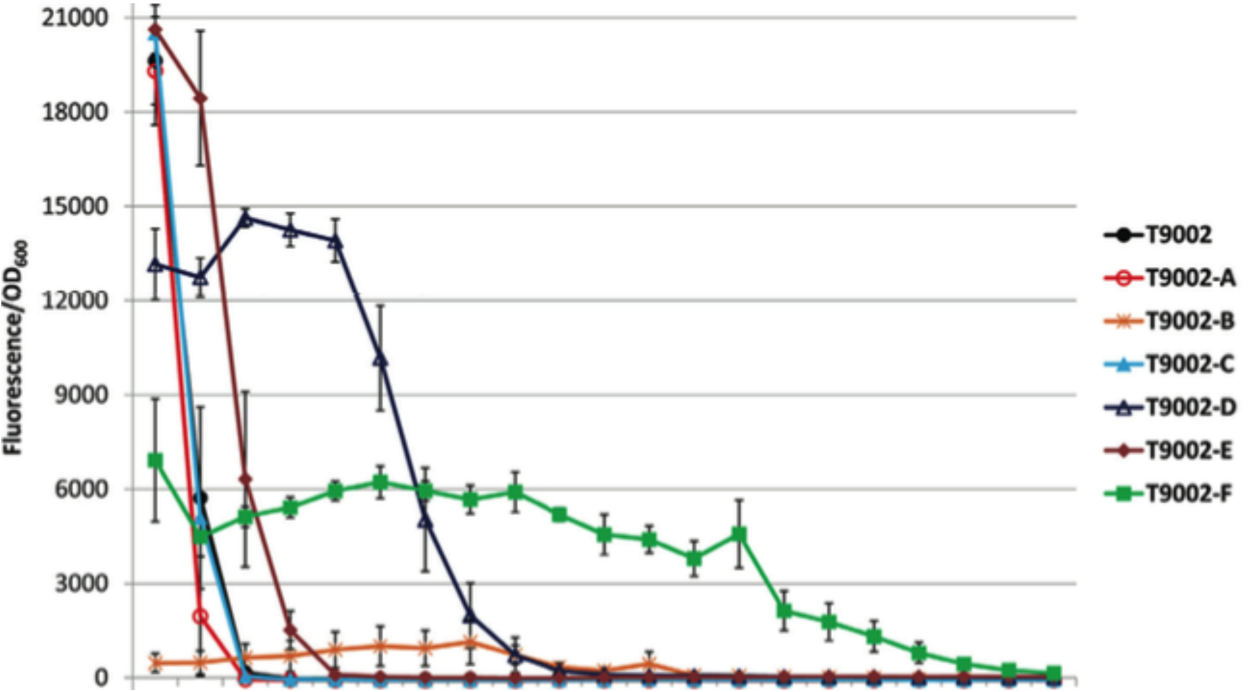Difference between revisions of "Team:Austin UTexas/Project/Problem"
Kvasudevan (Talk | contribs) |
|||
| Line 4: | Line 4: | ||
<hr> | <hr> | ||
<hr><br> | <hr><br> | ||
| − | <b | + | <b>Background</b><br><p> |
<hr> | <hr> | ||
| Line 10: | Line 10: | ||
<br></p> | <br></p> | ||
<br> | <br> | ||
| − | <b | + | <b>Project and Motivation</b><br><p> |
<hr> | <hr> | ||
The stability of the sequence is the focus of our research over the course of the summer. <b>We wish to identify and better characterize sequences that contribute to the relative instability of genetic devices so they can be used to predict device longevity, as well as be taken into account when creating and modifying such devices</b>. In the spring of 2015, UT iGEM team members utilized the Evolutionary Failure Mode (EFM) calculator designed by the Barrick lab to identify sequences within fluorescent protein coding genes that were more likely to break, or mutate. The EFM calculator identifies repeat-mediated deletion sites (characterized by long chains of the same base that makes it easier for replication errors) and simple sequence repeat sites in sequences where mutations are more likely to happen, and gives a relative instability prediction (RIP) score. Higher RIP scores indicate more sequences where the gene is likely to break, and we used this information to form hypotheses and determine which fluorescent protein coding genes in our inventories are the most and least evolutionary stable. | The stability of the sequence is the focus of our research over the course of the summer. <b>We wish to identify and better characterize sequences that contribute to the relative instability of genetic devices so they can be used to predict device longevity, as well as be taken into account when creating and modifying such devices</b>. In the spring of 2015, UT iGEM team members utilized the Evolutionary Failure Mode (EFM) calculator designed by the Barrick lab to identify sequences within fluorescent protein coding genes that were more likely to break, or mutate. The EFM calculator identifies repeat-mediated deletion sites (characterized by long chains of the same base that makes it easier for replication errors) and simple sequence repeat sites in sequences where mutations are more likely to happen, and gives a relative instability prediction (RIP) score. Higher RIP scores indicate more sequences where the gene is likely to break, and we used this information to form hypotheses and determine which fluorescent protein coding genes in our inventories are the most and least evolutionary stable. | ||
Revision as of 03:52, 18 September 2015
Problem: Genetic Instability
Background
One of the major issue facing genetic engineering is the overall longevity of genetic devices once inserted into organisms. An organism can be modified, but that does not ensure that the modification will last. Subsequent generations of modified organisms often lose or “break” the genetic device through mutations. Mutations that cause the inactivation of a plasmid or an inserted device decrease the metabolic load of that organism and allow the mutant and its descendants to replicate and grow faster than the originally modified organism, allowing the “broken” mutant to overtake a population. Previous research has determined several factors that contribute to the breaking of genetic devices. A major source is the level of expression and overall metabolic cost of the genetic insert to the organism.
The stability of the sequence is the focus of our research over the course of the summer. We wish to identify and better characterize sequences that contribute to the relative instability of genetic devices so they can be used to predict device longevity, as well as be taken into account when creating and modifying such devices. In the spring of 2015, UT iGEM team members utilized the Evolutionary Failure Mode (EFM) calculator designed by the Barrick lab to identify sequences within fluorescent protein coding genes that were more likely to break, or mutate. The EFM calculator identifies repeat-mediated deletion sites (characterized by long chains of the same base that makes it easier for replication errors) and simple sequence repeat sites in sequences where mutations are more likely to happen, and gives a relative instability prediction (RIP) score. Higher RIP scores indicate more sequences where the gene is likely to break, and we used this information to form hypotheses and determine which fluorescent protein coding genes in our inventories are the most and least evolutionary stable.
Over the summer, these three plasmids were used to transform four strains of bacteria (Top-10, MDS-42, BL-21 (DE3), BW-25113). Growing these transformed strains in culture and monitoring their fluorescence and stability will hopefully elucidate more regarding patterns in the sequences that contribute to the instability of genetic devices. Understanding this could lead to more stable devices and thus could increase the longevity of genetically modified organisms.

